Overview:
In this tutorial, I would like to show you a simple implementation of Choreography Saga Pattern with Spring Boot.
Over the years, Microservices have become very popular. Microservices are distributed systems. They are smaller, modular, easy to deploy and scale etc. Developing a single Microservice application might be interesting! But handling a business transaction which spans across multiple Microservices is not fun! In order to complete an application workflow / a task, multiple Microservices might have to work together.
Let’s see how difficult it could be in dealing with transactions / data consistency in the distributed systems in this article & how Saga Pattern could help us.
A Simple Transaction:
Let’s assume that our business rule says, when a user places an order, order will be fulfilled if the product’s price is within the user’s credit limit/balance. Otherwise it will not be fulfilled. It looks really simple.
This is very easy to implement in a monolith application. The entire workflow can be considered as 1 single transaction. It is easy to commit / rollback when everything is in a single DB. With distributed systems with multiple databases, It is going to be very complex! Let’s look at our architecture first to see how to implement this.
We have an order-service with its own database which is responsible for order management. Similarly we also have payment-service which is responsible for managing payments. So the order-service receives the request and checks with the payment-service if the user has the balance. If the payment-service responds OK, order-service completes the order and payment-service deducts the payment. Otherwise, the order-service cancels the order. For a very simple business requirement, here we have to send multiple requests across the network.
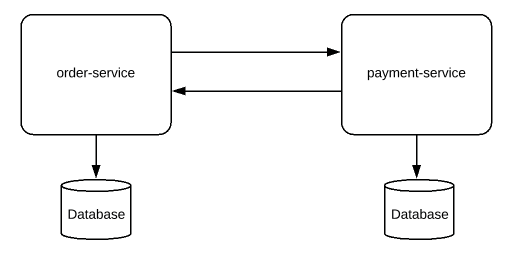
What if we also need to check with inventory-service for the availability of inventory before making the order as complete! Now you see the problem?
In the traditional system design approach, order-service simply sends a HTTP request to get the information about the user’s credit balance. The problem with this approach is order-service assumes that payment-service will be up and running always. Any network issue or performance issue at the payment-service will be propagated to the order-service. It could lead to poor user-experience & we also might lose revenue. Let’s see how we could handle transactions in the distributed systems with loose coupling by using a pattern called Saga Pattern with Event Sourcing approach.
Saga Pattern:
Each business transaction which spans multiple Microservices are split into Microservice specific local transactions and they are executed in a sequence to complete the business workflow. It is called Saga. It can be implemented in 2 ways.
- Choreography approach
- Orchestration approach
In this article, we will be discussing the choreography based approach by using event-sourcing. For orchestration based Saga, check here.
Event Sourcing:
In this approach every change to the state of an application is captured as an event. This event is stored in the database/event store (for tracking purposes) and is also published in the event-bus for other parties to consume.
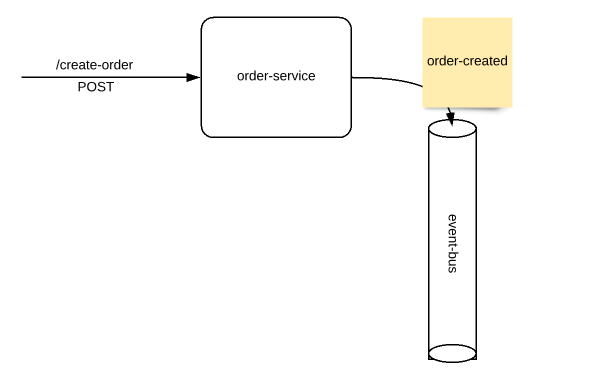
The order-service receives a command to create a new order. This request is processed and raised as an order-created event. Couple of things to note here.
- OrderCreated event basically informs that a new order request has been received and kept in the PENDING/CREATED status by order-service. It is not yet fulfilled.
- The event object will be named in the past tense always as it already happened!
Now the payment-service/inventory-service could be interested in listening to those events and reserve/reject payment/inventory. Even these could be treated as an event. Payment reserved/rejected event. Order-service might listen to these events and fulfill / cancel the order request it had originally received.
This approach has many advantages.
- There is no service dependency. payment-service & inventory-services do not have to be up and running always.
- Loose coupling
- Horizontal scaling
- Fault tolerant
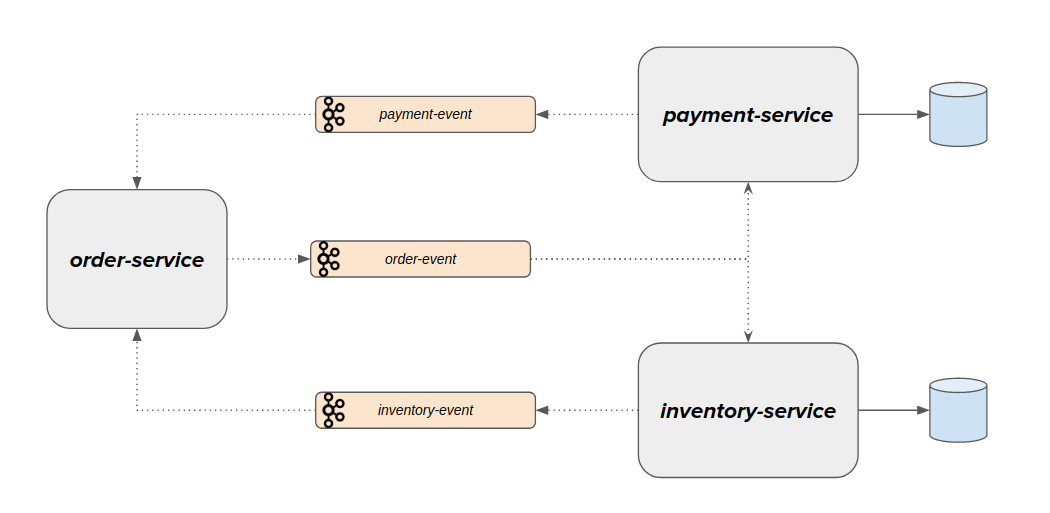
The business workflow is implemented as shown here.
- order-services receives a POST request for a new order
- It places an order request in the DB in the ORDER_CREATED state and raises an event
- payment-service listens to the event, confirms about the credit reservation
- inventory-service also listens to the order-event and conforms the inventory reservation
- order-service fulfills order or rejects the order based on the credit & inventory reservation status.
Choreography Saga Pattern – Implementation:
- I create a simple Spring Boot project using kafka-cloud-stream. I have a simple project structure which looks like this.
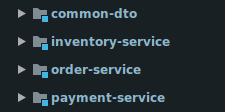
- My common-dto package is as shown below.
- It contains the basic DTOs, Enums and Event objects.
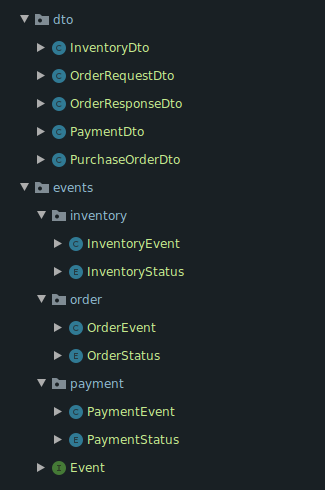
Payment Service:
The payment service consumes order-events from a kafka topic and returns the corresponding payment-event. Take a look at the GitHub link at the end of this article for the complete working project.
@Configuration
public class PaymentConfig {
@Autowired
private PaymentService service;
@Bean
public Function<Flux<OrderEvent>, Flux<PaymentEvent>> paymentProcessor() {
return flux -> flux.flatMap(this::processPayment);
}
private Mono<PaymentEvent> processPayment(OrderEvent event){
if(event.getOrderStatus().equals(OrderStatus.ORDER_CREATED)){
return Mono.fromSupplier(() -> this.service.newOrderEvent(event));
}else{
return Mono.fromRunnable(() -> this.service.cancelOrderEvent(event));
}
}
}Inventory Service:
We also have inventory-service which consumes order-events and returns inventory-events.
@Configuration
public class InventoryConfig {
@Autowired
private InventoryService service;
@Bean
public Function<Flux<OrderEvent>, Flux<InventoryEvent>> inventoryProcessor() {
return flux -> flux.flatMap(this::processInventory);
}
private Mono<InventoryEvent> processInventory(OrderEvent event){
if(event.getOrderStatus().equals(OrderStatus.ORDER_CREATED)){
return Mono.fromSupplier(() -> this.service.newOrderInventory(event));
}
return Mono.fromRunnable(() -> this.service.cancelOrderInventory(event));
}
}Order Service:
We first create a Sink through we which we would be publishing events.
@Configuration
public class OrderConfig {
@Bean
public Sinks.Many<OrderEvent> orderSink(){
return Sinks.many().unicast().onBackpressureBuffer();
}
@Bean
public Supplier<Flux<OrderEvent>> orderSupplier(Sinks.Many<OrderEvent> sink){
return sink::asFlux;
}
}- order events publisher
@Service
public class OrderStatusPublisher {
@Autowired
private Sinks.Many<OrderEvent> orderSink;
public void raiseOrderEvent(final PurchaseOrder purchaseOrder, OrderStatus orderStatus){
var dto = PurchaseOrderDto.of(
purchaseOrder.getId(),
purchaseOrder.getProductId(),
purchaseOrder.getPrice(),
purchaseOrder.getUserId()
);
var orderEvent = new OrderEvent(dto, orderStatus);
this.orderSink.tryEmitNext(orderEvent);
}
}- Order service also consumes payment and inventory events to take decision on the order.
@Configuration
public class EventHandlersConfig {
@Autowired
private OrderStatusUpdateEventHandler orderEventHandler;
@Bean
public Consumer<PaymentEvent> paymentEventConsumer(){
return pe -> {
orderEventHandler.updateOrder(pe.getPayment().getOrderId(), po -> {
po.setPaymentStatus(pe.getPaymentStatus());
});
};
}
@Bean
public Consumer<InventoryEvent> inventoryEventConsumer(){
return ie -> {
orderEventHandler.updateOrder(ie.getInventory().getOrderId(), po -> {
po.setInventoryStatus(ie.getStatus());
});
};
}
}@Service
public class OrderStatusUpdateEventHandler {
@Autowired
private PurchaseOrderRepository repository;
@Autowired
private OrderStatusPublisher publisher;
@Transactional
public void updateOrder(final UUID id, Consumer<PurchaseOrder> consumer){
this.repository
.findById(id)
.ifPresent(consumer.andThen(this::updateOrder));
}
private void updateOrder(PurchaseOrder purchaseOrder){
if(Objects.isNull(purchaseOrder.getInventoryStatus()) || Objects.isNull(purchaseOrder.getPaymentStatus()))
return;
var isComplete = PaymentStatus.RESERVED.equals(purchaseOrder.getPaymentStatus()) && InventoryStatus.RESERVED.equals(purchaseOrder.getInventoryStatus());
var orderStatus = isComplete ? OrderStatus.ORDER_COMPLETED : OrderStatus.ORDER_CANCELLED;
purchaseOrder.setOrderStatus(orderStatus);
if (!isComplete){
this.publisher.raiseOrderEvent(purchaseOrder, orderStatus);
}
}
}- I am unable to provide the entire project code here. So do check the GitHub link for the complete source code.
Demo:
- Once I start my application, I send an order request. The productId=3 costs $300 and user’s credit limit is $1000.
- As soon as I send a request, I get the immediate response saying the order_created / order_pending.
- I send 4 requests.
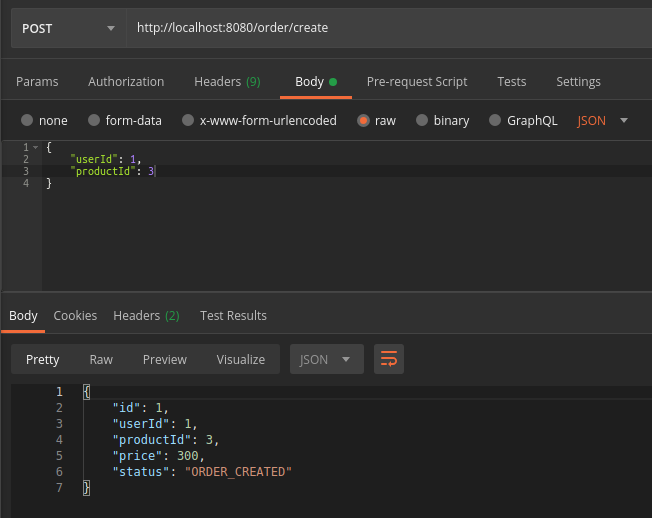
- If I send /order/all requests to see all the orders, I see that 3 orders in fulfilled and the 4th order in cancelled status as the user does not have enough balance to fulfill the 4th order.
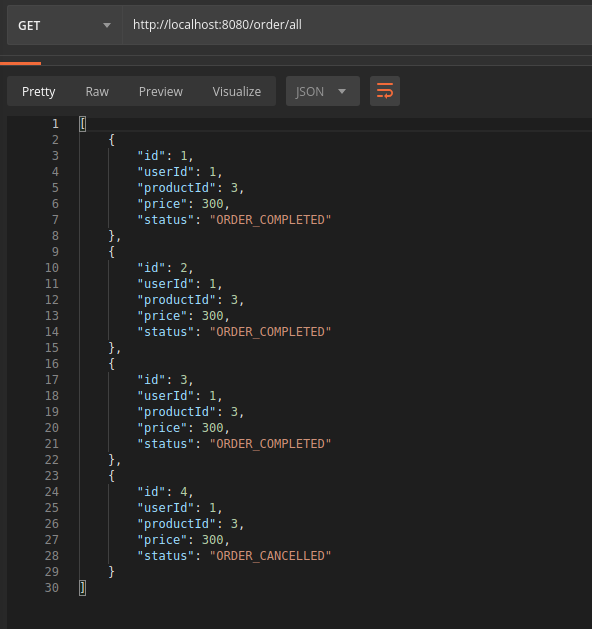
- We can add additional services in the same way. For ex: once order-service fulfills the order and raises an another event. A shipping service listening to the event and takes care of packing and shipping to the given user address. Order-service might again listen to those events updates its DB to the order_shipped status.
As we had mentioned earlier, committing/rolling back a transaction which spans multiple microservices is very challenging. Each service should have the event-handlers, for committing / rolling back the transaction to maintain the data consistency, for every event it is listening to!
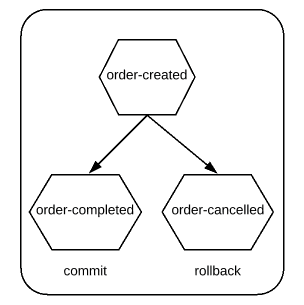
Summary:
We were able to successfully demonstrate the Choreography Saga Pattern with Spring Pattern.
Learn more about other Microservices Design Patterns:
- Microservice Pattern – Orchestration Saga Pattern With Spring Boot + Kafka
- CQRS Pattern – Microservice Design Patterns
- Scatter Gather Pattern – Microservice Design Patterns
- Materialized View PostgreSQL – Microservice Design Patterns
The source code is available here.
Happy learning 🙂


Thanks for this. I have couple of query’s on this
1) you have created payment and order service in one component, it should be separate components right?
2) Let’s say, we have order and workflow services, and the workflow id in order, think that workflow created successfully and while creating order it failed. In this case, we have to delete workflow entry, how we can handle this scenario?
Hi,
1. You are right. In real life, order and payment services should be 2 different microservices. Just for this article, I had placed them in 2 different packages to quickly run and demo. I could have used multi-module maven project.
2. This is a great question. MicroServices communicate among themselves by raising an event. In this case, when the payment failed, order-service cancelled the order. Similarly, in your case, the workflow might have been crated successfully. But when the order fails for some reason, it has to raise an event. Workflow service will consume the event and cancel the status / delete etc.
Thanks for the quick reply. When comes to delete case:
1) Delete event can be raised either if the transaction is not successful or for any run time exception from catch block, right?
2) Is there any mechanism instead of raising a delete event, the publisher gets the response back, if failure we can delete?
Hi Vins,
I want to remove kafka with solace it that possible?
We could use any streaming platform like kafka, redis, pulsar..etc. I used Kafka just for this demo.
Hi,
Thanks for such a great tutorials. Could you please create tutorials using link – https://chrisrichardson.net/post/sagas/2019/12/12/developing-sagas-part-4.html ?
It will be good option to have if without Spring Flux too. Expecting positive response from your side.
Sure!
Hi vlns,
Did you get a chance to create one ? Looking for positive response from your side. Many Thanks!
Hi, I want to ask you a question. If payment service or inventory service have a delay (2-3 seconds) or one of them fails what will be the response of the order service?
Till we get all the responses, the status will be order_created. again this is for demo purposes. You can update as per your needs.
Thank you for this tutorial. I am new to microservices and, part of my internship is to help come up with an architecture for a desired application as a proof of concept. My question is: Can we have both API Gateway pattern and Saga pattern at the same time? What I mean by that is to have an API gateway for simple request calls, while having event based communications to handle requests that requires making calls to multiple services.
Yes, you can.
Hey Vinoth,
Nice post and I even bought your UDEMY course recenty to understand the reactive concepts which you used here in this article. I have a doubt on Kafka could see properties files have been configured with kafka details but where in code have you used to emit events in kafka or am i missing something.
Thank you!
Hi,
I use Spring Boot framework which does it automatically. For the complete code, check the github link.
Hi Vins,
Thanks for great tutorials. Could you please create tutorials about Spring Boot and reactor kafka?
Thanks
Neha
Hi Vinsguru
How is the UI going to be for this event driven order system. Generally, once the order is placed, the user see the response if the order is cancelled or fulfilled right away. i.e. the same http call returns the result. If user has to see what happens to the order then UI has to keep calling /order/ ?
The UI can be updated via Server Sent Events as and when you have an update. When the user places an order, order will be in ORDER_CREATED status. success/failure will be decided later. usually within few milli seconds. The advantage is – it is non blocking and will scale very well. It does not have to worry about if the other apps are up and running. In your case, where you say the user will see the status immediately, if one of the service is not available, what will happen? the order will have to fail. Not in this case.
Thanks Vinsguru for your reply.
Do you have the example with UI and Server Sent Events. Any other example apart from this is also fine.
The solution looks pretty good, but even for a simple use case like this, it could get very complex.
How do you handle the case when the payment is reserved but let’s say you could not reserve the inventory(The SKU went out of stock in the meanwhile)? Does the order service create another event “OutOfStock” and the payment services listens to it to rollback the payment?
How do you handle the case when the payment failed but the SKU inventory gets reserved? You may want the user to revise their payment info. If they don’t, the order service could raise an event “PaymentDeclined” which the inventory service could listens to to rollback the inventory
Any pattern will not be a silver bullet for all the problems. They all have their own pros and cons. So, yes, it might look complicated. But actually it is not. The idea here is – they all communicate via events. So payment is reserved and inventory failed. payment service will rollback the transaction by listening to the events. Probably we could use an orchestrator as discussed here – https://www.vinsguru.com/orchestration-saga-pattern-with-spring-boot/
Could you please also update the Spring Boot version here as well?